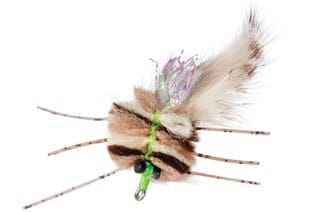
In my opinion, there is no better tying material when twisting up a fly pattern than a piece of zonker (rabbit). The qualities of a zonker strip far exceed those of any other natural tying material. This is especially true when designing small patterns for saltwater use.
A zonker strip breathes and moves in the water like no other material; each hair appears to come alive once immersed! It is also considered the most durable of all the natural materials. The hide of a rabbit strip holds up even to toothy critters for extended periods. I have had patterns tied primarily with rabbit take over 10 bluefish before requiring a re-tie – and even then it was because the pattern’s other materials (such as bucktail) were completely shredded.
Anytime I have an opportunity to design a pattern using rabbit, I’m extremely confident it will be a hit with the species I’m targeting. That is the kind of confidence no fly-angler should be without. Best of all, rabbit is extremely user-friendly and very easy to work with.
Beginnings of the Crabbit
Back in 2006 I was preparing to take a group of anglers to Casa Blanca in Mexico’s Ascension Bay for a week of permit, tarpon, snook and bonefishing. Our group consisted of 22 folks, most of whom were seasoned anglers. Eleven were from my usual crew, which makes an annual fishing pilgrimage together, while the others signed up for the trip at our local fly shop, The Fish Hawk. Nearly everyone had their sights set on catching a permit, and prior to leaving, I suggested to my group of 11 to make sure they had plenty of flies tied with rabbit.
The lodge deems a half-dozen permit taken in a week by 22 anglers to be extremely good fishing. Yet by week’s end, my crew of 11 had hooked 11 permit and landed seven! I even hooked two on the first two good casts I made into a small pod of fish. Perhaps not surprisingly, six of those 11 hookups came on a rabbit fly we dubbed the Crabbit.
The Crabbit not only accounted for permit but also a number of bonefish and a 20-pound tarpon that eventually shook off. The fly had totally eclipsed all expectations! Unfortunately, the 11 folks from the fly shop had not even hooked one permit all week, despite the fact that everyone had numerous shots at permit feeding either as singles or in both small and large groups.
A Versatile Pattern
Since that trip, the Crabbit has been used to take redfish from coastal Carolina to Florida’s west coast. It has also gained a reputation taking striped bass along the New England and mid-Atlantic regions during the late spring and early-summer months, when the bass are found on the flats feeding on crabs.
The Crabbit is nothing more than a crab pattern tied using a piece of zonker. When trying to imitate a specific species of crab, all one needs to do is change colors and/or size. When fishing the flats of Ascension Bay, you’ll want to use as light a color of fly as possible. White or cream on a #4 or #6 hook is the color of choice when tying Crabbits used for Mexican permit. If targeting redfish, a darker-colored fly on a #2 or #1 hook would be better served; either a light tan or even a rust-colored crab would be my color preference. Meanwhile, for anglers tossing crabs on northeastern flats for stripers in the spring and summer, a dark tan or brown pattern tied on a larger hook, such as a #2 to 1/0, makes for an ideal combination.
The Best of Both
The Crabbit was designed as a hybrid fly of sorts. It is a cross between a Del Brown permit fly (Merkin) and a Bonefish Scampi. Both of these patterns are proven winners and have been for many years. The Crabbit simply takes the best attributes of both and combines them into one heck of a crab design. When looking closely at a Crabbit, it could even be said that it has a similar yet shortened look compared to a Tarpon Toad (designed by Gary Merriman). But the Crabbit is tied differently from the Toad and much more similarly to a Bonefish Scampi.
In addition to a strip of zonker, the Crabbit also uses Aunt Lydia’s rug yarn, which further enhances its shape as a crab. Add in Sili Legs and some pearl Mylar along the hook shank, and you have a pattern that elicits some vigorous strikes when either beginning its descent to the bottom or when slowly moved along the bottom.
The key to fishing a Crabbit (or any crab fly, for that matter) is to be patient and barely move the fly. I have had my best success with short, 1- to 2-inch twitches. If a fish is following the fly but will not eat, make a long, slow strip after the short twitches. That kind of a move makes your pattern appear to be a crab fleeing from a predator, and it usually elicits a reactionary strike.
Next time you are thinking about tossing a crab pattern, tie up a couple Crabbits. They are fast and easy to tie – and best of all, they will not disappoint!
Materials
Hook: Tiemco 811S (sizes #6 to 1/0)
Thread:** 140 denier** (chartreuse)
Eyes: Lead dumbbell (sizes XS to M)
Flash: Pearl Mylar (size S or M)
Carapace: Aunt Lydia’s rug yarn (cream, tan, brown or rust)
Legs: Sili Legs
Tail: Zonker strip (tan, brown, rust or barred tan/brown)
Tying Instructions
| Step 1: Tie in dumbbell eyes with hook point riding down (Clouser style), and incorporate pearl Mylar at bend in hook. |
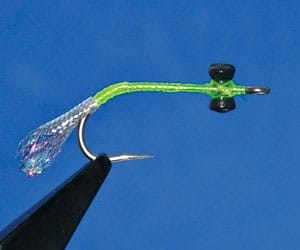
| | Step 2: Tie in carapace (rug yarn) with hook point riding up. Comb out rug yarn before trimming to shape.|
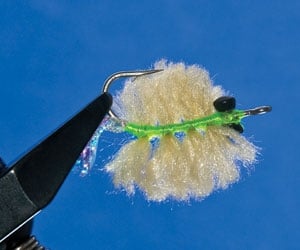
| | Step 3: Add three pieces of Sili Legs by using two half-hitch knots to tie them in.|
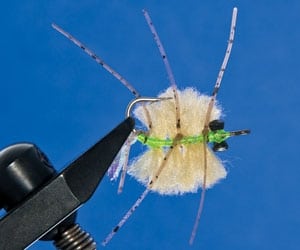
| | Step 4: With hook point still riding up, lay zonker strip along the hook and poke a hole in the hide where the zonker would penetrate hook point. Place zonker through the hook point and lay entire strip against hook shank. Pulling firmly on zonker strip at the front of the fly, tie down at hook eye. Flare out Mylar (Gotcha style). Coat thread wraps with glue.|
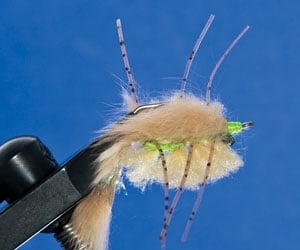
|









